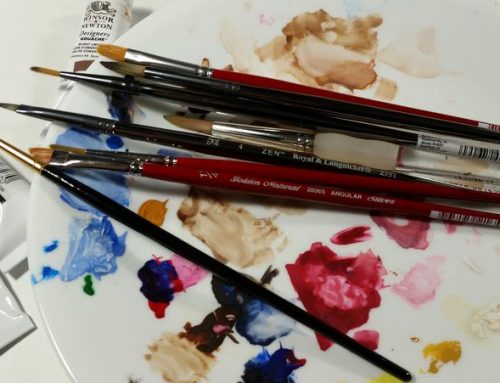“Writing is rewriting.” It’s so cliche that even among cliches it’s cliche. But it’s so very true. No matter what you’ve written, you’ll likely spend two-to-four times longer rewriting. If you’re taking much longer than that, then you’ve probably got something so profoundly wrong with your text that you need something more drastic than a series of rewrites will cure. (Keep in mind that you should use what works for you. This tip is mostly comprised of general methods, things that work for me, and things that work for writers I know.)
When I write a first draft, I don’t stop to look at what I’ve written. I’m always moving forward. Every day I must put down my minimum number of words or pages (for novels and screenplays, respectively — currently running 2,000 words or six pages, though the averages tends to skew higher in practice). Many writers I know like to go back over the previous day’s writing (no more than that), make corrections, and use that to get the momentum to start the day. I’ve not found that either method gives a clear advantage to the quality of the draft, so I opt for the first as it saves me a little time.
Rewrites start the second you’ve finished your first draft. The general rule of thumb is to put the manuscript in a drawer for a couple of weeks before even reading it — unless you’re getting paid to meet a deadline and can’t afford the delay. Give yourself a little bit of time to decompress and MAYBE get some perspective. I don’t think writers CAN get perspective in just two weeks, but it’s a nice excuse for a little break.
After the rest period, it’s time to go to work. My personal suggestion is to read it once all the way through without writing any notes. Read it quickly. The big clunky parts of the story will shout at you to fix them. Make a mental note, but don’t dwell on it too much.
 After that first read-through, grab your red pen and a pad of paper, and slowly read through the manuscript — noting everything that’s annoying you. Sentence by sentence. Be brutal. More brutal than you would be if you were reading someone else’s work. Take regular breaks at least once every half-hour to an hour. Why? If you don’t, you’ll start scrimping on the notes. You’ll be thinking ahead. By taking the breaks you are only worrying about what’s in front of you. On the manuscript itself, do only simple changes; save the lengthy changes, as well as notes to yourself, for the pad.
After that first read-through, grab your red pen and a pad of paper, and slowly read through the manuscript — noting everything that’s annoying you. Sentence by sentence. Be brutal. More brutal than you would be if you were reading someone else’s work. Take regular breaks at least once every half-hour to an hour. Why? If you don’t, you’ll start scrimping on the notes. You’ll be thinking ahead. By taking the breaks you are only worrying about what’s in front of you. On the manuscript itself, do only simple changes; save the lengthy changes, as well as notes to yourself, for the pad.
Once you’re finished, you can either re-edit the manuscript in-place, or retype it all. I strongly recommend retyping it. Have the original manuscript in hand, as well as all of your notes. Type the entire story from the beginning using all these materials as well as whatever pops into your head as you’re writing. Yes, it’s more work than the other way, and more time-consuming, but you get the bonus that you are now writing a story you are already familiar with. You’ve already practiced it. You have a good idea of the things that need fixing. By retyping it you don’t get lazy and simply cut and paste passages because it’s easier. You’ll find that you not only catch a lot of errors, but you also have a surprisingly good time. Except for those scattered patches that need extensive changes, most of it is not too bad. PLUS, your touch-typing improves .
At this point all of your major story problems should be resolved. If you aren’t confident, show the text to someone who you trust will be honest about it (this will be about one in ten readers you line up — you’ll come to treasure the trusted ones). Tell them that now isn’t the time to nitpick, but instead to find the big problems. On the other hand, if you are confident about the story, then you can keep it to yourself for the time being.
Now you get to read the story over and over again. And again. And again. Nitpick. Fix everything that’s amiss. Punctuation. Grammar. A turn of phrase. The rhythm of a sentence. Also, try to tighten up the text as much as possible. Often writers are told by their editors to cut a sixth to a fourth of the words out of the manuscript for “marketing reasons”. Sad to say, it usually results in a better and easier to read story. (So what does it say about me that my stories inevitably get longer?) Also note that if, after all of these reads, the emotional scenes still affect you, well, you’ll know that you did those scenes OK.
Miscellaneous technical rewriting things to look out for:
- Passive voice – “Tim decided to go to the market.” vs “Tim went to the market.” vs “Tim dashed to the market.”
- Excessive alliteration – Wary writers worry when words wander. Don’t try to be too cute. Your readers will thank you.
- Repeating the same word too near in proximity to a previous instance – This is so very common as you get a word stuck in your head and in the rush to get to the next line you don’t realize how often you are using it. However, it’s useful for dialog as it is how we speak.
- Grammar – Writers words use good, always.
- Punctuation – You know, those pesky commas, apostrophes, dashes, the dreaded semicolon, etc.
- Purple prose– Overly ornamental and “descriptive” words that break the narrative flow and draw attention to themselves. Again, don’t try to be too cute.
When you think you’ve got the story nailed down, now’s the time to give it to a few people to read. Don’t give it to too many… probably no more than three. Listen to suggestions that point out stuff you missed and you think will help a story, and especially pay attention to anything two or more of your readers have a consensus about. You can filter some of the comments by what you know of people’s preferences, but otherwise, use them for the broad strokes.
A note about readers. A lot of people don’t know how to “read”. Even if they do read all of your work, they often don’t give useful comments. At least not initially. For civilian readers, I try to engage them in conversation about the work. Over the course of an hour or more, you can find out a lot of what did and didn’t work for them. In terms of readers, the grail is a professional writer (or experienced amateur) with no other agenda than to help you make your work the best it can be. Use, don’t abuse, these resources when they cross your path.
I think one of the hardest parts of the process is listening to people criticize your creation…your baby. As long as it’s constructive and honest, treasure all of those nuggets even if they hit your psyche hard enough to raise a welt. You don’t want readers who fawn. That doesn’t help you. You want readers who are honest.
Once you’ve incorporated the changes you’ve accepted from your readers, attack the story by reading it aloud to yourself. As you’ve doubtless noticed, for some reason people like authors to read their work. Make sure it can be read out loud without too much silliness (or better yet, none). Pay attention to see if your characters all sound the same when they speak or think, or if they have their own voice (don’t affect the voice yourself, just use the words as if you were recording a book on tape).
Now it’s just polishing. If there is anything that bugs you, even a little, then fix it. When you get to the point where you are changing text, and then changing it back, and then changing it back again– you’re done. You aren’t rewriting any more, you’re just putting off sending it out.
I’d recommend letting one more reader have a crack at it, listen to their suggestions, likely ignore them, and then start sending out your story. Oh… and have someone other than yourself proofread the thing one last time. There will always be errors that slip through, but it’s important to catch as many as possible.
Now… one last little item. I suggest you write your manuscript, from the start, in standard format. Yeah, I know… it’s harder to read and you use a lot more paper. However, when it comes to doing the corrections, it’ll be tons easier. And, the more you use it, the less you notice the double spacing and stuff. Plus, when it’s ready to send out, you’ll already be done. The only time to consider putting it in a more conventional form is for those readers who aren’t used to the standard format. I’ll sometimes take the time to reformat so that it’s easier for them to read.
Rewriting is a pain in the arse. There’s no getting around it. It’s time-consuming and often tedious. When you’re rewriting yourself, it’s even more difficult. Still, this is a huge part of the craft of writing. All writers have to become good at it. The editors aren’t going to do it for you — they’ll just buy the piece from the writer who DID do all the work.
And speaking of editors. When you send out your writing, some (bloody few, but some) editors will give you notes. Editors who want to buy your story will definitely give you notes. If you are going to listen to anyone, listen to them –especially the ones from well-established publishing houses. About 90% of what they tell you will definitely help the story. The other 10%? Usually it’s just an opinion that won’t much affect the saleability one way or the other, so use it or not at your discretion. Even if you think it’ll make the story suck, do a rewrite making the changes they suggest. You’ll be surprised that it usually makes the story better. If it doesn’t, tell them so and why. As for producers (i.e. for screenplays)… Anecdotal wisdom says that scant few know anything about anything. For them, you just nod your head knowingly, and then go ahead and do what you wanted to do in the first place (I exaggerate, but only slightly).
The best part about rewriting is when you compare your first draft to what you ended up with. You can’t help but admit to yourself that it was actually worth all that effort.





